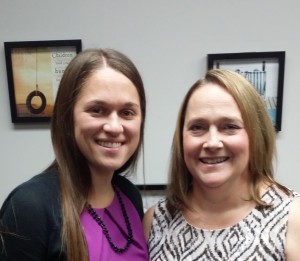Instructional coaches have a lot of challenges, given their workload and inability to be everywhere at once. Some instructional coaches support as many as 30 teachers or more. This makes it very difficult to build trusting relationships as well as consistently set goals, observe teachers, and track progress.
Virtual instructional coaching through asynchronous video observation has great potential to reduce costs and allow instructional coaches to work from anywhere and at anytime. However, it does take robust technology, planning, process, and well-trained coaches and willing teachers to make the process successful.
We recently had the chance to interview Julie Scarlato, an education consultant with the Hamilton County Educational Service Center that supports 22 school districts in Ohio, and Anna Freeman, a second year teacher who was remotely coached by Julie this past school year through the Sibme platform on how to make virtual coaching work effectively.
Interview with Julie Scarlato and Anna Freeman
How long have you been an educator, and why did you go into the field of education?
Julie: I have been an educator for 23 years. I went into the field of education because I loved being around children and I was fascinated by how children learn and develop. I was also inspired by my Dad and two of my aunts who were educators as well.
Anna: I just completed my second year of teaching. I went into the field of education because when I was a child I thought that teachers knew absolutely everything; I was amazed! I wanted to be one of those special people who knew everything. As I got older, I worked with kids in many different settings such as babysitting or being a camp volunteer. Those experiences solidified for me the fact that I wanted go into the field of education and become a teacher.
Julie, as an instructional coach, what is your coaching philosophy?
My coaching philosophy is based upon the process of self-reflection. I feel that an instructional coach should give positive feedback and use reflective questioning to help teachers use reflection to uncover ways to grow in their professional practice.
Anna, what is your favorite part about being a teacher?
My favorite part of being a teacher is the positive relationships I am able to build with my students. I like that they have someone at school they feel comfortable talking to. I know it is not easy being a child in school and sharing your feelings with anyone, let alone a teacher. It makes me feel trusted by my students that they share things with me. I also love that every day is something different. Yes, there are routines and procedures that occur every day, but the children are the special variable that make every day interesting and new.
Julie, had you ever used video as a professional development tool at HCESC before using the Sibme platform?
I had used video embedded into presentations to show examples of teachers using particular instructional strategies, or to share an experts’ ideas on instructional practices but I had never used it in this manner.
Julie, why do you think videotaping teachers has the potential to improve teaching practice?
I feel videotaping, particularly when it is done by the teacher themselves, helps to get a true picture of what is going on in the teacher’s classroom. It allows teachers to watch themselves as well as their students in the natural environment of the classroom. Without another person in the room, the students will behave as they normally do and the teacher will get a true picture of what occurs while they are teaching a lesson. This helps the teacher be able to reflect on every aspect of the lesson as they may not recall exactly how they interacted with their students or how the students reacted during every part of the lesson. The video allows the teacher to repeatedly watch parts of a lesson to analyze the various components and make necessary adjustments and set goals for professional growth.
Anna, how have you used video this past year to help improve your teaching practice?
I have used video this past year to help improve my teaching practice by being more self-reflective of all my lessons, whether I videotape them or not. The videos helped give me a true picture of what my students were doing while I was teaching. I took all the information I learned about my classes and students and continued to use it in every lesson I taught. I felt I became a more effective teacher. I also spent even more time planning for lessons to help scaffold my students’ learning in the beginning and searching for ways to connect it with other subjects or real-world situations when the lesson was over.
Anna, do you think it helped accelerate your development as a professional teacher? Why?
I definitely think videotaping myself teach helped me accelerate my development as a professional teacher. I see it this way, you can read something numerous times in a textbook, but until you experience it, you won’t truly understand the meaning behind it. I could have any number of people come in my room, watch me teach, and then give me constructive feedback. But until I was able to watch myself teach and see what they were talking about, I didn’t really understand it. I have gotten invaluable feedback and ideas from my virtual coach, but I also notice things when I watch videos of myself teaching; it makes me feel a little like a coach of myself.
What is your favorite Sibme feature?
Julie: My favorite Sibme feature is the time-specific video annotation. This feature is so powerful because it allows the teachers I coach to view the exact moments of the lesson that sparked my reflective questions or my positive feedback.
Anna: One of the main things I love about Sibme is how easy of a platform it is to use. It did not take long to upload my videos from my iPod Touch over my school’s wireless network or have a discussion about them. As far as my favorite feature of Sibme, that is between the private workspace and the time-specific video annotations. I liked the private workspace so much because it gave me a chance to view a video before I submitted it to a huddle. I always watched my videos first to see how the lesson went and it helped me with the discussion aspect of a coaching cycle. The time-specific video annotations were great because I was able to easily see the moments my coach was referring to and I could go back and watch those moments again.
Julie, when it comes to recording, hosting, and sharing videos there are different solutions. Why did HCESC choose Sibme?
We chose Sibme for its ease of use and collaborative nature. The price is also quite reasonable for all of the features that are available through the platform.
Julie, as you move forward, how do you intend to leverage the Sibme platform with your current instructional coaching process at HCESC?
As we move forward with our current instructional coaching processes at HCESC, we will utilize the Sibme platform to provide more intense, efficient coaching cycles for teachers across a continuum of experience.
Anna, how do you intend to leverage the Sibme platform with your colleagues next year at your school?
There are so many ways that my school could utilize Sibme and I really want to get a start on some of them next year. I feel my colleagues and I are just barely scratching the surface of all the beneficial uses of Sibme. We are going to have training sessions for Sibme so everyone can see how easy it is to use and they don’t just have to take my word for it. I am going to stress the positive results I have experienced because of using Sibme and how my students are getting a better teacher each time they walk into my classroom. By videotaping myself teach, I’m constantly learning about myself as an educator and I am constantly growing. I want my colleagues to experience the same positive results.
Julie, if you were to offer advice to both instructional leaders and teachers who are considering implementing video-enhanced professional learning or coaching into their workflow, what would you say?
I would borrow from Nike and say “just do it”! It’s easier than you think and you learn along the way, always tweaking and enhancing as you go. The powerful impact it can have is worth the investment. I think most will find that it allows us to be more efficient and effective with our time and money.
Anna, if you were to offer any advice to your peers who are reluctant to videotape and reflect on their instruction, what would you recommend?
I would express to them how much I have learned about myself as an educator and how much I have grown this past year. The better teacher I am, the better education my students are getting. This is the bottom line to me. What teacher doesn’t want their students to be getting a great education?



